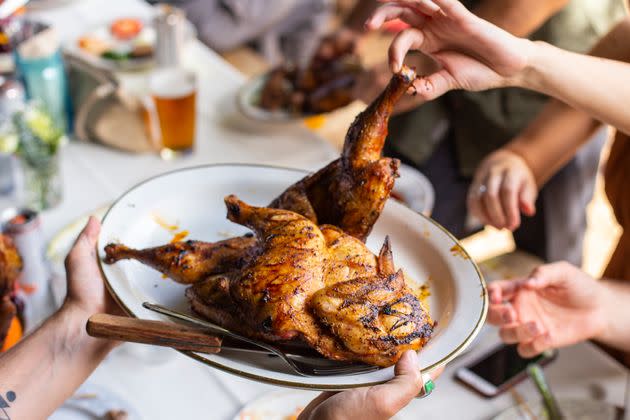How To Make Grilled Chicken That's Perfect Every Time
With Memorial Day, the Fourth of July and other festivities packed into the summer months, now is the time to start getting your grill ready for backyard barbecues. If your cookout repertoire usually includes grilled chicken — a popular but notoriously tricky BBQ staple — read on for expert tips on how to prevent chicken from drying out on the grill and how to keep it flavorful, juicy and perfectly charred.
Bring the chicken to room temperature before putting it on the grill.
One easy way to improve the texture and cooking quality of grilled chicken is to “let the chicken reach room temperature before it goes on the grill,” said Rodney Scott, founder and pitmaster of Rodney Scott’s Whole Hog BBQ in Charleston, South Carolina. Putting cold, straight-out-of-the-fridge chicken on a hot grill will result in a dried-out exterior and underdone interior, so Scott recommends “taking it out of the fridge about 30 minutes before you start grilling.” Room temperature chicken will grill much more evenly and will better retain its moisture.

Consider switching from breast meat to chicken legs if you want a juicier result.
Keep the grill’s temperature at medium to medium-high.
It may seem more efficient to crank the grill up to its highest temperature, but when you’re cooking grilled chicken, Brian Jupiter, executive chef of The Frontier Chicago and Ina Mae Tavern in Chicago, says “the best way to keep grilled chicken from drying out is to grill at a medium to medium-high temperature. Oftentimes, grillers are overzealous about how hot the grill needs to be and turn it all the way up. By using a lower temperature, you can still get your grill marks, but with a more consistent cook.”
Don’t cook your chicken directly over the grill flame.
Intense and direct heat won’t do your chicken any textural favors. Therefore, it’s best both to lower the overall temperature of your grill and to resist the urge to put the chicken right on top of the flames.
“Use a grill that is properly heat soaked (or preheated) and dedicate a section to allow for indirect cooking,” explained grilling expert and cookbook author Paul Sidoriak of Grilling Montana. “This could mean turning off one of your gas burners or pushing charcoal to one side and cooking the meat adjacent to the flames rather than on top of them. This will allow the chicken to cook much more evenly, and it should retain its moisture. This can also be achieved cooking chicken on the elevated bun rack, which most grills have, but few people use for cooking meat.”
Always keep a meat thermometer on hand and make sure to cook the chicken until it reaches an internal temperature of 165 degrees Fahrenheit for food safety.
Brining the chicken beforehand will keep it moist and tender.
To lock the moisture inside the chicken throughout the grilling process, “let your chicken brine before you grill,” said pitmaster and cookbook author Ed Randolph of Handsome Devil in Newburgh, New York. “The introduction of a brine increases the moisture throughout any cut of chicken, and the saltiness and acidity of the brine make for an extra tender end result.”
You can use either a wet brine (with salt, sugar, and water) or a dry brine (with just salt and herbs), and the chicken should start brining just a few hours before it goes on the grill.
Marinate the chicken beforehand and baste it on the grill.
If brining is the secret weapon to perfectly textured grilled chicken, then a marinade, which can include oil, vinegar, mustard, barbecue sauce and any number of herbs and seasonings, is the key to standout flavor.
“Don’t be afraid to marinate!” suggested Owen McGlynn, the executive chef and owner of Asheville Proper in Asheville, North Carolina. “I’ll use whatever is in the fridge to throw together a quick mustard marinade or chimichurri. Baste the chicken with the marinade through the cooking process to add a little crust.”
Consider swapping out chicken breasts for chicken thighs.
Chicken breasts may be quick-cooking crowd pleasers, but chicken thighs offer more room for error and ultimately a juicier eating experience.
“Chicken breasts cook extremely quickly and take on a rubbery texture when overcooked,” Jupiter explained. “Part of the reason for this is because the breast has almost no fat. Chicken thighs have a large quantity of fat and are much more forgiving than chicken breasts. This is because once the fat melts, it lubricates the meat, ultimately keeping it moist. Thighs, compared to breasts, can also stand up to much higher heats and pair perfectly with a slight char.”
Consider grilling a spatchcocked whole chicken.
If you’re willing to take on a small project, then spatchcocking a whole chicken (removing the backbone and pressing it flat) can make for an excellent cookout entree.
“Start with a great product,” advised chef Samuel Kim of Baekjeong Korean Barbecue in California. “Look for an organic, 3- to 4-pound roaster. Buy the whole bird; the bones and the skin will protect the meat while grilling. They also add tremendous flavor. Brine the chicken to prevent it from drying out during grilling, then spatchcock the chicken so when it’s on the grill, the legs/thighs cook at the same rate as the breast.”
Kim lets the brined chicken rest in the fridge for up to 48 hours before putting it on a medium-high grill skin-side down, and grilling until the internal temperature reaches 165 degrees.

 Yahoo Movies
Yahoo Movies 